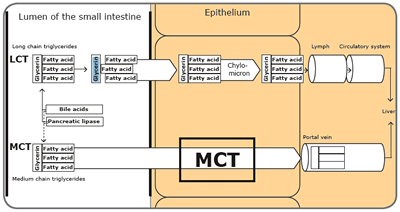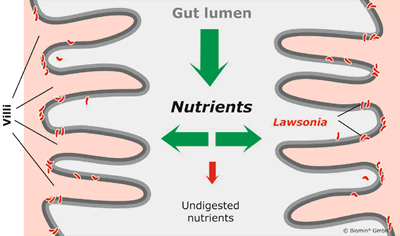
Biotronic® GutPower in swine - innovation on the horizon
The main ingredients of Biotronic® GutPower are butyric, caprylic and capric acids in the protected glycerides form. The benefi cial form of protection guarantees gastric by-pass and slow release of acids in the intestine where all acids become active. Butyric acid is a fuel for the enterocytes. It modifi es gut structure by enlarging villi length and crypt depth which essentially improves nutrient absorption. Butyric acid increases enzymatic activity, enhances the reparation of gut wall lesions caused by intestinal diseases and nutritional imbalances and enhances barrier function of gut epithelium. Butyric, caprylic and capric acids act as antibacterials in the gut, especially caprylic and capric acids, are very strong antimicrobials at the higher pH value of the intestine. Moreover, triglycerides of caprylic and capric acids are easily absorbed from the gut, supplying the animal with an immediate boost of energy.Butyric acid is a feed additive that is able to infl uence gut health resulting in better performance. Due to the unpleasant persistent odor of butyric acid, protection of the product is needed. Another reason for protection is to obtain complete intestinal arrival of butyric acid and subsequent release of the active substance in the small intestine. Encapsulation of acids is a known form of protection, however butyric acid content in well encapsulated products can be only relatively low.
PERFECT PROTECTION
The most benefi cial protection is in the form of glycerides which is a chemical compound of acids and glycerol. The advantage of this protection is a high amount of active ingredients - about 78% (Figure 1). The glycerol-acid compound is not infl uenced by the pH level or digestive enzymes of the stomach; therefore these compounds reach the small intestine where the gradual release of the acids through the action of lipases takes place.

Figure 1. Protection of acids in form of glycerides
MODE OF ACTION
Biotronic® GutPower increases absorptive surface of intestine
Butyric acid is an efficient nutrient for the intestinal mucosa, increasing the density and length of villi and enlarging the absorptive surface of the intestine. Figure 2 shows the part of intestinal wall, villus and enterocytes.

Figure 2. Intestinal wall
Prof. Claus from University Hohenheim is one of the scientists who investigated the infl uence of butyric acid on changes of epithelial cells. A trial was carried out on 75 day old pigs over a 5 days period. The study found that butyric acid increases the villus height, villus area and number of villi per plica signifi - cantly in comparison to the negative control group (Table 1).
Table 1. Influence of butyrates on morphological characteristics of jejunum
| Jejunum | Control |
Butyrate |
% Improvement |
| Villus height, nm | 1.5a |
2.2b |
47% |
| Villus area, mm2 | 2.7a |
4.2b |
56% |
| Villus number | 22.9a |
31.0b |
35% |
Butyric acid also infl uences the balance of cell formation (mitosis) and cell death (apoptosis), and as a result more epithelial cells are active in producing digestive enzymes and absorbing nutrients. When talking about cell regeneration, it has to be mentioned that the mucosal layer is completely regenerated within a few days. About 30% of nutritive energy is spent on the gut. By improving intestinal metabolism part of this energy can be saved for performance.
Biotronic® GutPower increases enzymatic activity
The trial of Prof. Claus described above, shows improved enzymatic activity of sucrase in the intestine of pigs consuming butyrate (Table 2).
Table 2. Influence of butyric acid on sucrase activity.
| Sucrase activity, U/ml | Control | Butyric acid |
| Proximal jejunum | 4.9 | 18.8 |
| Distal jejunum | 108 | 212 |
| Ileum | 61.7a | 119.1b |
Biotronic® GutPower enhances the barrier function of the gut
Enhancing gut barrier function is also one part of the mode of action of butyric acid. Butyrate upregulates the expression of tight junction proteins making the penetration of Salmonella and other bacteria through the epithelial layer diffi cult and avoiding the invasion of bacteria in the blood (Figure 3). The complementary action of the acids in Biotronic® GutPower is on the one hand keeping the pathogens in the intestinal lumen and on the other hand reducing the amount of pathogens in the gut.

Figure 3. Tight junctions in the intestine
Biotronic® GutPower acts as an antimicrobial via different strategies
Butyric, caprylic and capric acids are also known as antibacterial agents against pathogenic microorganisms, including Salmonella, Clostridia, Escherichia coli, Campylobacter. In particular, caprylic and capric acids are strong antimicrobials at higher intestinal pH value. Antibacterial activity of medium chain fatty acids (capric, caprylic) is higher than short chain fatty acids (formic, acetic, propionic, butyric) against gram positive and gram negative bacteria (Nakai et al., 2002). Medium chain fatty acids have a synergistic ability to suppress the expression of the genes required for invasion and to reduce the number of bacteria in vivo (Immerseel et al., 2004). Caprylic, capric and butyric acids down regulate the pathogenicity gene of Salmonella by decreasing the expression of hil A gen, a key regulator related to the invasion capacity of Salmonella in intestinal epithelial cells (Gantois et al., 2006; Immerseel et al., 2004 ).
Medium Chain Triglycerides - immediate boost of energy
Caprylic and capric acids are the main constituents of medium chain triglycerides (MCT). MCT can diffuse through the enterocyte wall without the assistance of carriers, which supplies the animal with fast available energy (Figure 4).

Figure 4. MCT and LCT penetrating epithelium.
FIELD TRIAL
The effect of butyric acid glycerides was tested on a commercial farm in Italy, which had problems with ileitis, caused by Lawsonia intracellularis. Figure 5 show the difference between a healthy gut and a subclinical or chronic form of ileitis.

Sectional view of a healthy gut Healthy intestinal mucosa and efficient nutrient uptake

Subclinical Ileitis Decreased nutrient absorption due to swelling of intestinal mucosa

Ileitis Loss of functionality of gut mucosa due to massive swelling
Figure 5. Influence of Lawsonia on intestinal mucosa.
The alteration of intestinal mucosa due to Lawsonia intracellularis can lead to impaired feed conversion and weight gain, as well as poor group uniformity.
The trial was carried out on 70-day-old fattening pigs for 64 days on a commercial farm in Italy with 850 Danbreed sows. 1025 pigs were divided into two groups. Both groups received Lincomycin & Doxycycline for the fi rst 14 days. One group received 0.2% Lincomycin and commercial acidifi er at 0.3% inclusion rate, whereas the other group received the dietary supplementation with glycerides of butyric acids at inclusion rate of 0.3%.
Results of the trial are shown in the Table 3. Final weight and daily weight gain were increased by 2 and 4%, in comparison with positive control group. Feed conversion rate (FCR) was improved by 5% and mortality and culls was also decreased compared to the positive control group.
Table 3. Effect of butyric acid glycerides on growth performance in pigs
| Positive control group | Butyric acid glycerides | |
| Number of animals | 510 | 515 |
| Age at trial beginning, d | 70 | 70 |
| Weight at trial beginning, kg | 25 | 25 |
| Final average weight d 134, kg | 63.15 | 64.35 |
| Daily weight gain, kg | 0.591 | 0.614 |
| FCR during trial | 2.78 | 2.64 |
| Mortality | 4 | 2 |
| Culls | 3 | 2 |
During the trial, blood and feces were analyzed to detect the presence of Lawsonia intracellularis. The Lawsonia antibodies were detected in blood of both groups. In feces the control and treated groups were negative to Lawsonia except for one positive 60 days after the beginning of the trial. The hematic analysis proved that it was impossible to eradicate Lawsonia from both the antibiotic and the glycerides group but it was possible to maintain animal performance.
The increased resistance to the infection by the piglets receiving glycerides of butyric acid can be attributed to:
- better gut and mucosa development
- increased capacity of repairing lesions caused by pathogens
- microflora control
The efficacy of Biotronic® GutPower was tested on piglets. A trial was carried out with weaned pigs in Center of Applied Animal Nutrition in Austria. 60 weaned piglets [(Landrace x Large White) x Pietrain] were divided into two groups with 3 replications (30 animals per group) that were homogeneous for weight and sex. One group received the diet containing no growth promoting feed additive, whereas the other two received the dietary supplementation with Biotronic® GutPower at inclusion rate of 1.5 kg/ton feed for starter period and 0.7 kg/t feed for grower period.
The dietary supplementation with glycerides of butyric, caprylic and capric acids improved animal growth performance as can be seen in Table 4. The final body weight and ADWG were increased by 2.1 and 3.3%, respectively, whereas FCR decreased by 2.2% in the trial group compared to these in the control group. The feed intake (FI) of Biotronic® GutPower group increased slightly. Although the differences between the groups were not signifi cant the results are substantial due to the very high performance level of the animals in both groups. The economic calculation shows the pay back of the product 4.6:1.
Table 4. Effect of butyric, caprylic and capric acids on growth performance in piglets
| Control | Biotronic® GutPower | |
| Initial weight, kg | 8.53 |
8.52 |
| Final weight age d 70, kg | 28.91 |
29.52 |
| ADWG, g | 484 |
500 |
| FI (g/animal/day) | 903 |
909 |
| FCR | 1.86 |
1.82 |
| Mortality | 1 |
0 |
| ROI | 4.6:1 |
CONCLUSION
Optimizing gut health is key to improving animal performance. Biotronic® GutPower assures gastric by-pass and release of acids in the intestine. This leads to an enlarged intestinal surface and improved nutrient absorption. Butyric, caprylic and capric acids protect the animal from pathogens through active action against microorganisms and upgrading of physical barrier function of the intestinal wall. Innovative product, Biotronic® GutPower, is a tool optimizing animal performance.

Benefits of the product
For Further Product Information Please Visit www.biomin.net
Featured Products

Biotronic®
Naturally ahead in dynamic acidification!
Related Articles

Biotronic®
Advantages of organic acids for feed and feed raw materials

Biotronic®
Efficiency of Biotronic® Product Line in Pigs

Biotronic®
Optimization of swine production by use of acidifiers

Biotronic® Top3
Biotronic Top3 to Capitalise on Perforizer Effect
Related Services

Mycotoxin Channel
World renowned experts answer mycotxin related questions.

Mycotoxins.info
A wealth of Mycotoxin information at your fingertips

World Nutrition Forum
The future of animal nutrition




